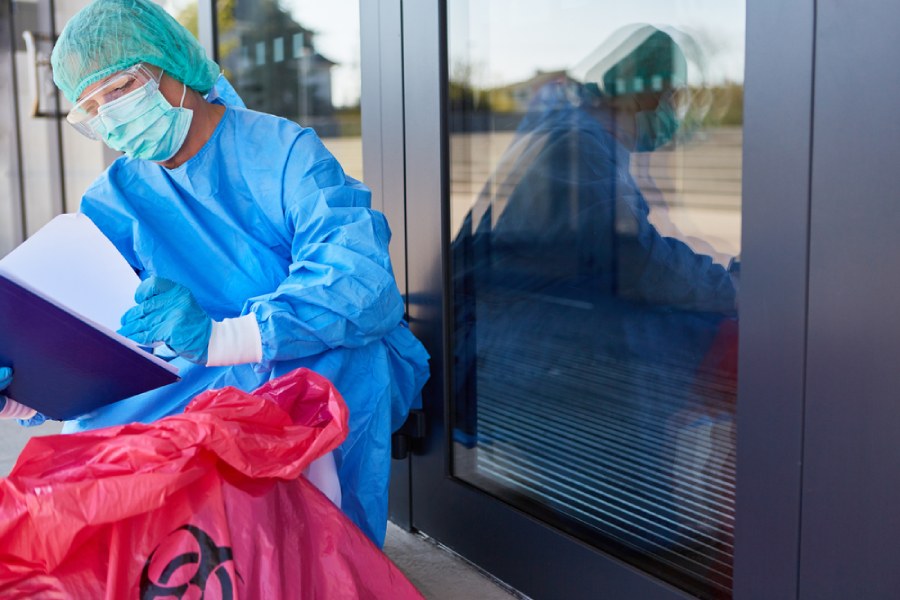Medical waste can be very confusing, what federal laws apply? What are my local state, city, or county requirements?
Healthcare facilities, veterinary clinics, and many other faculties generate over one million tons of biohazard waste annually. While most of this waste is harmless, approximately 15% poses a potential infection hazard. This is what’s known as biohazard waste.
Because of the associated risk, there are stringent procedures and processes required for proper disposal of biohazard waste.
The infectious materials pose a risk of spreading disease in humans, animals and the environment. Biohazard waste is typically treated in an autoclave process which renders the waste harmless and then it is disposed of.
The University of Oregon created a great in-depth spreadsheet that gives direction on how to stay compliant with all relevant biohazard waste disposal guidelines. But we here at MedPro Disposal are also experts in biohazard waste management, disposal, and treatment. Read along to learn more about best-practices for biomedical and biohazard waste.
Biohazard Waste Disposal Guide
The lifecycle of the management of biohazard waste is as follows: generation, accumulation, handling, storage, treatment, transport, and disposal. [iii]
In the United States, biohazard waste management is regulated by the Environmental Protection Agency (EPA) and the Occupational Safety and Health Administration (OSHA) , via Title 40 and Title 29, Subpart H – Hazardous Materials of the Code of Federal Regulations (CFR), respectively.
Additionally, the Center for Disease Control (CDC) also provides guidelines for the management of biohazard waste.
Finally, each state, university, center, company, facility, or organization has its own standards and practices. Discussed in this blog will be the recommendations, guidelines, and standards of the WHO and the United Nations (UN).
We have put together this handy three-step guide to disposing of biohazard waste and hope you find it useful.
From identifying what biohazard waste is to the management, collection, and treatment of it. MedPro Disposal provides all the important facts and answers to your questions.
How to Dispose of Biohazard Waste in 3 Steps
Step 1: Identify The Type of Waste
Biohazard or infectious waste disposal is generally more expensive than your regular garbage disposal. There are many reasons for this, but the main one is there are many more steps biohazardous waste has to go through before it meets the landfill. Mainly, it has to be sanitized and put into a specialized landfill called a sanitary landfill specially made to stop animals from taking the waste, and to stop water run-off.
Because of this increased cost and health issues associated with disposing of biohazard waste improperly, it is worth the extra time deciding if the waste you are about to throw away should go into a red bio-bag or the regular garbage.
OSHA provides a more comprehensive list for biohazardous waste regulations, but there is a broad overview of what’s involved in determining if something is biohazard waste:
- Was the item used to hold blood?
- Is the item saturated or dripping in blood?
- Could the item be infectious?
- Did the item come from a contaminated room?
- Did the item come from a surgical procedure?
If you answer yes to any of the above, it is safe to throw the waste into a red biohazard bag UNLESS it can puncture the bag, in which case it must be disposed of in a sharps container.
Step 2: Storing Biohazardous Waste
What happens to biohazard waste after it goes into a biohazard bag? It must be put into another container for transportation. The reason we do this is to 1) comply with local and federal regulations and 2) to stop any leakage or spillage of waste.
Most of the time when a bio bag is full it is put into a specialized cardboard box designed to transport medical waste. Some states, like California, require that the waste is put into a specialized plastic tote. It all depends on the regulations in each state. At MedPro Disposal, we are experts in varying state and local regulations and when hired for biohazard waste management and disposal, we make sure to follow all relevant regulations and laws.
Step 3: Disposing of The Waste
This is the easy part! Once the waste is put into the correct container, you simply have your medical waste disposal company come and pick it up. Of course, all of our haulers are trained for proper transportation of waste.
After it’s picked up, the waste is then treated. Treatment after disposal is done in two ways.
Biohazard waste will be either incinerated or put into an autoclave for sanitation. Incineration is starting to phase out due to the environmental impact, due to the fact waste is burned and ashes are taken to a landfill.
Autoclave is more of an expensive sterilization, but ensures the least environmental impact. This process is done by using high levels of heat and light to pressurize and sanitize the biohazardous waste.
Learn more about the journey waste goes through after it’s picked up on our blog.
Or, call us for a Quick Quote at 888-641-6131



